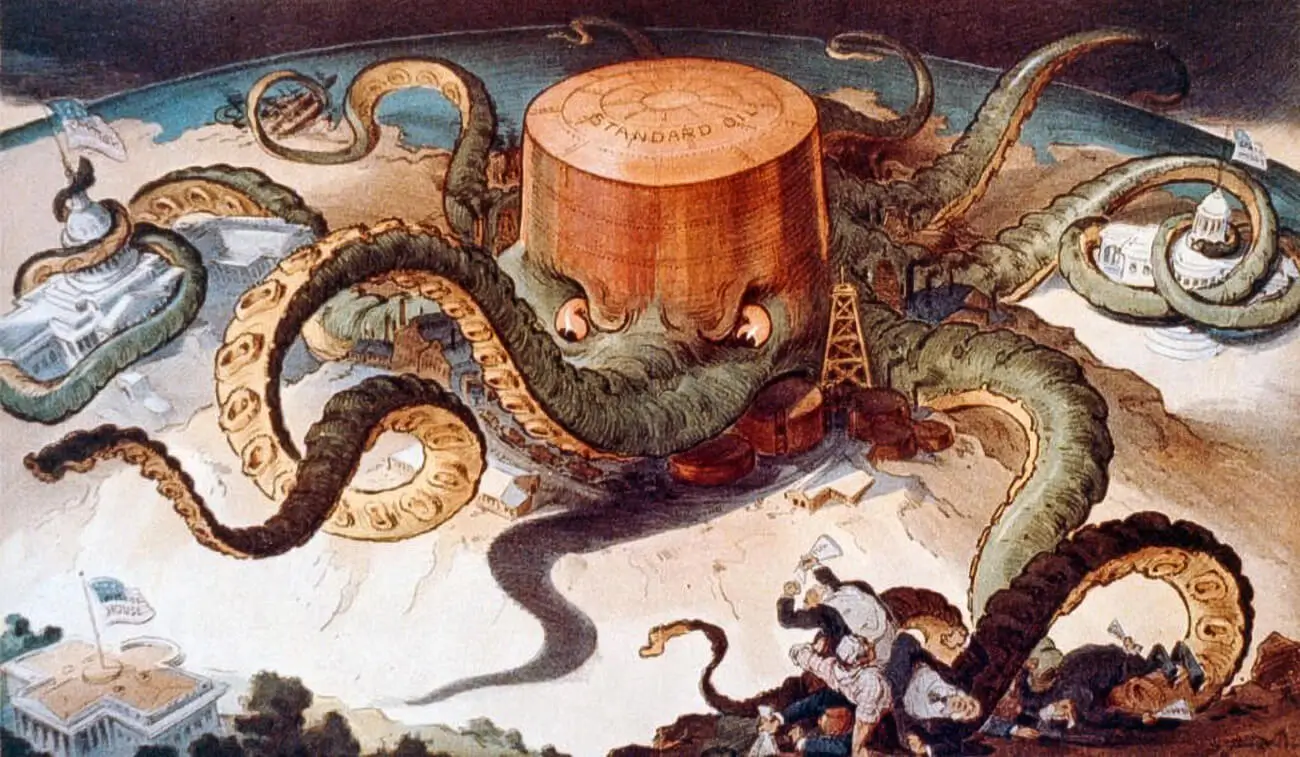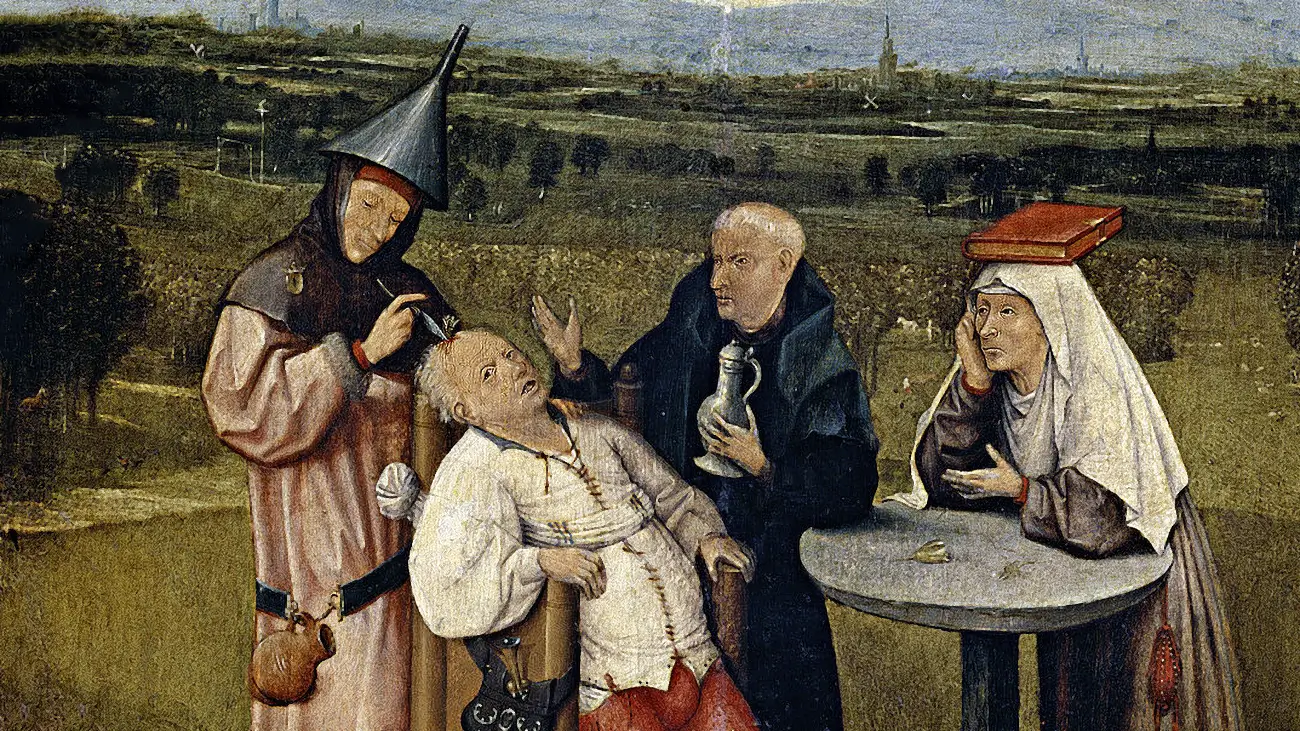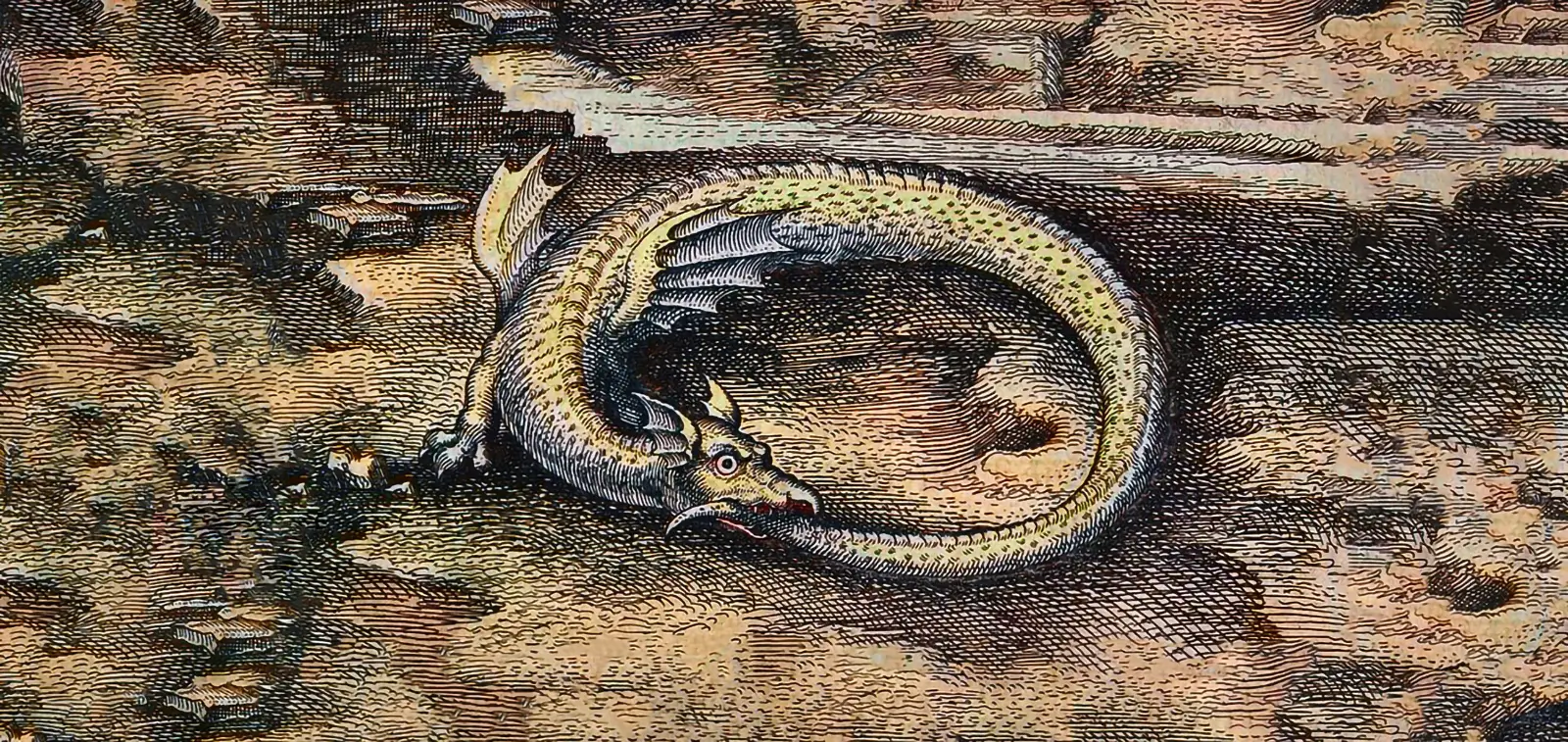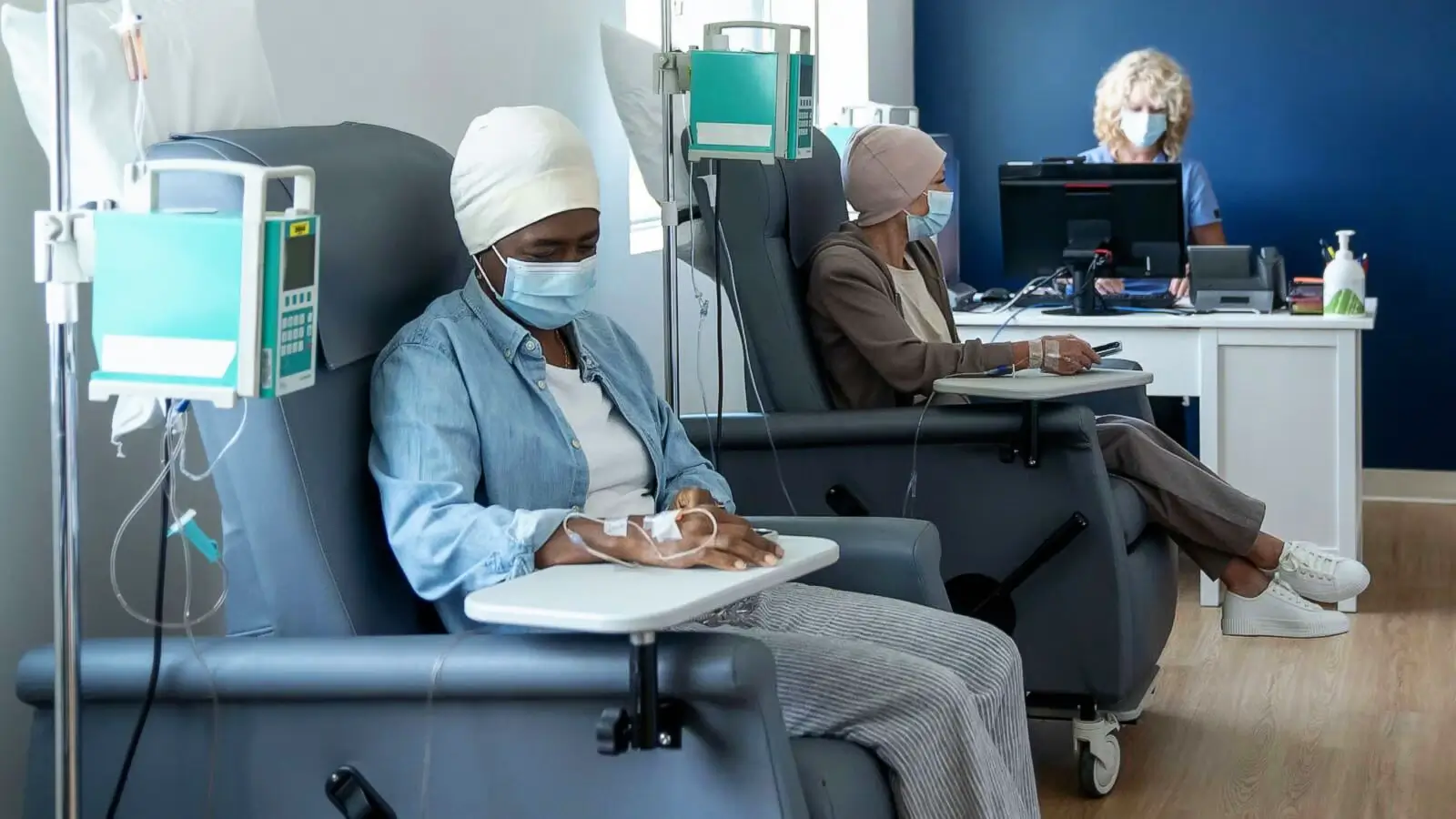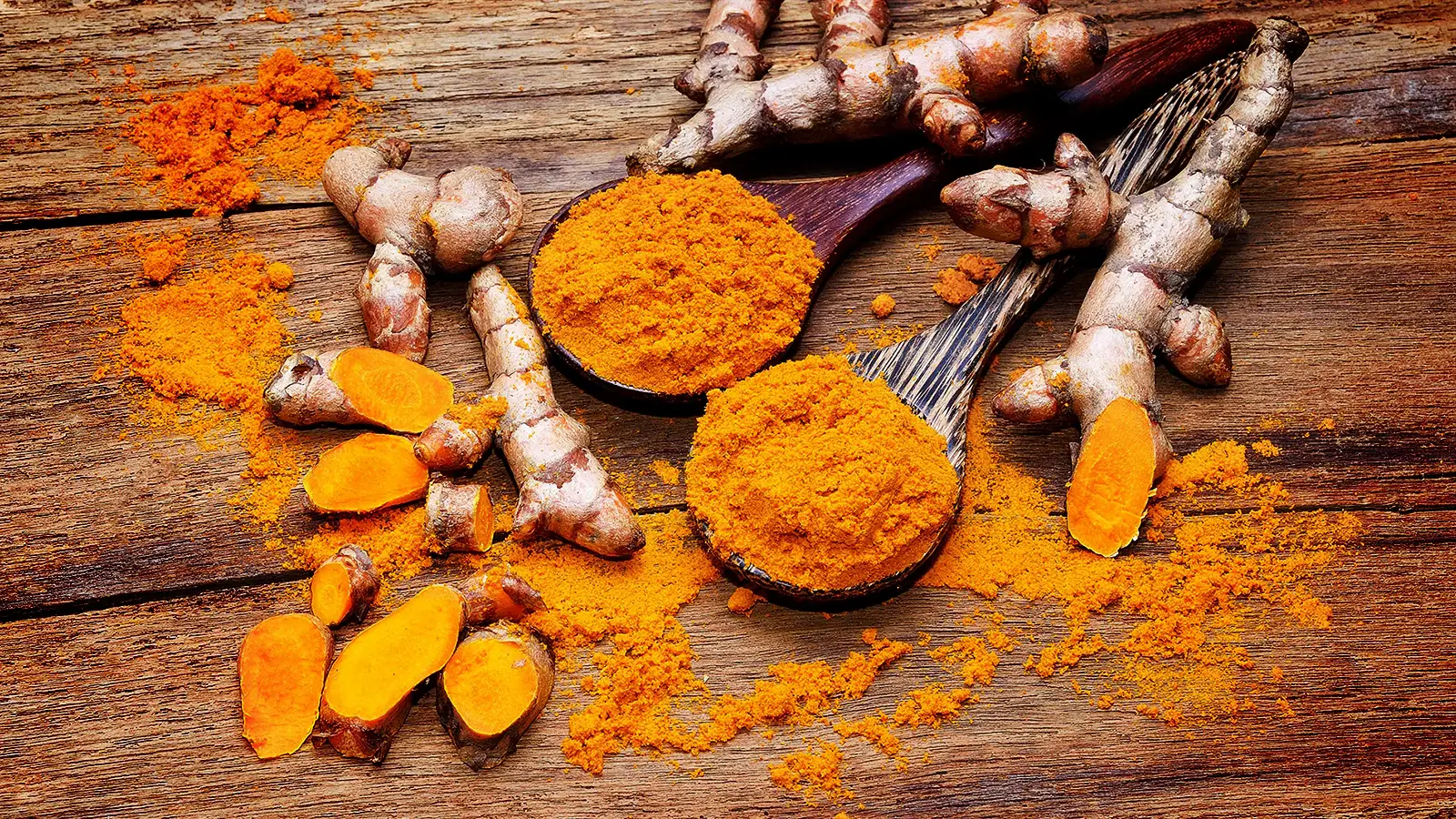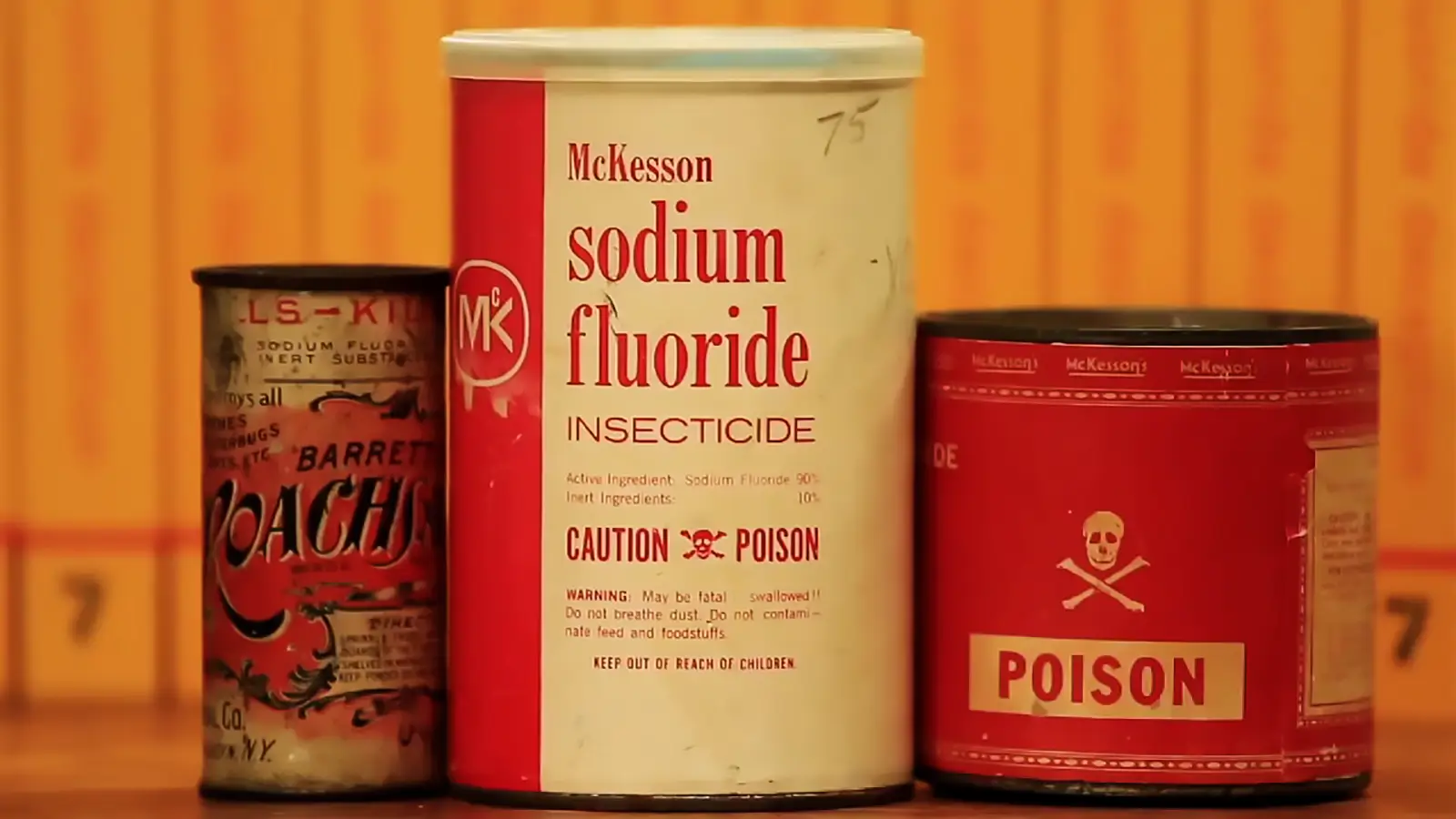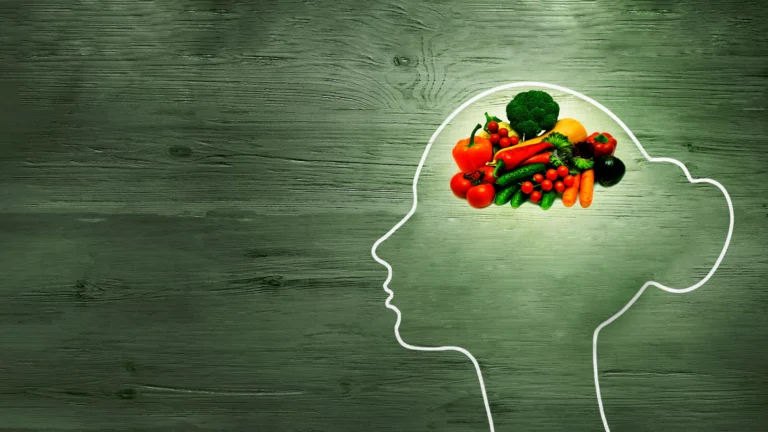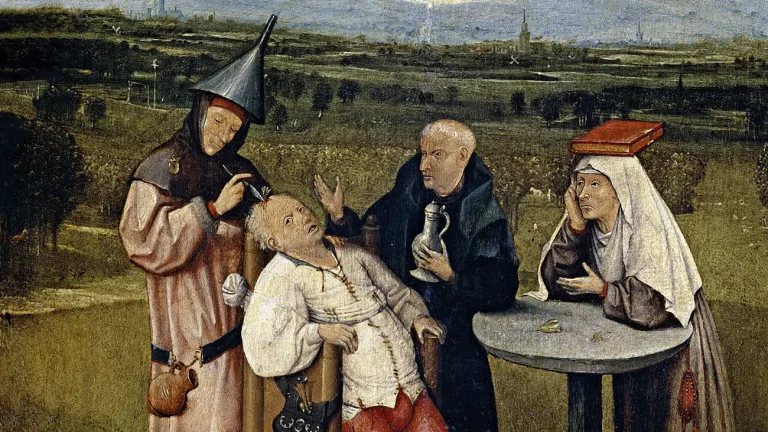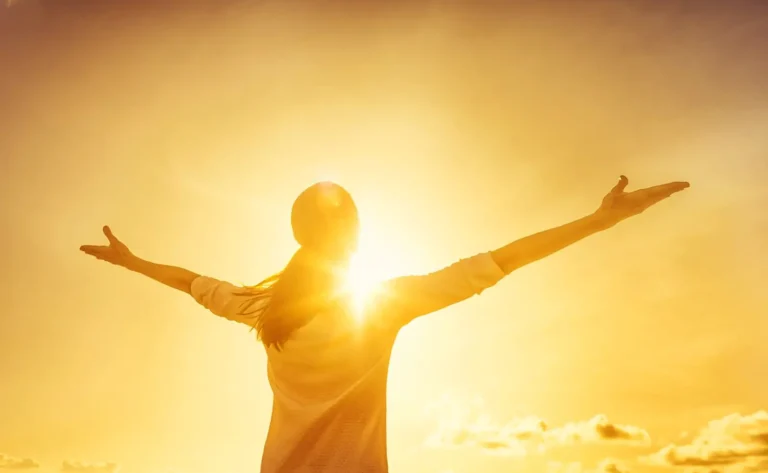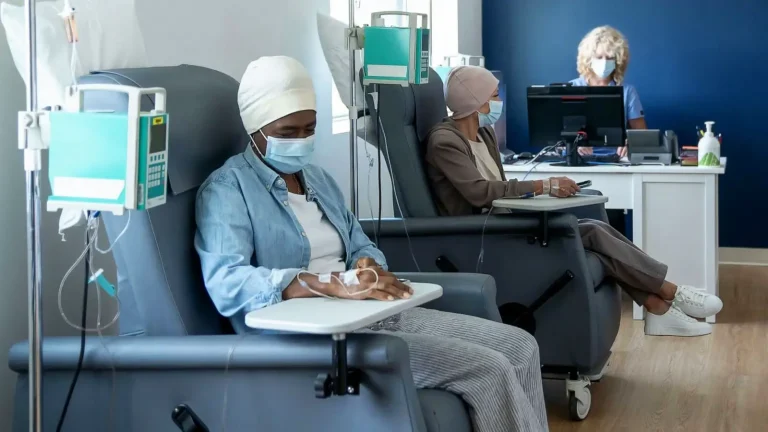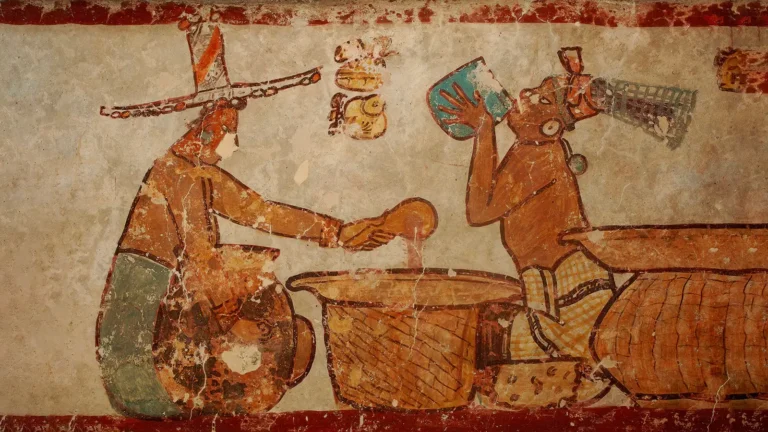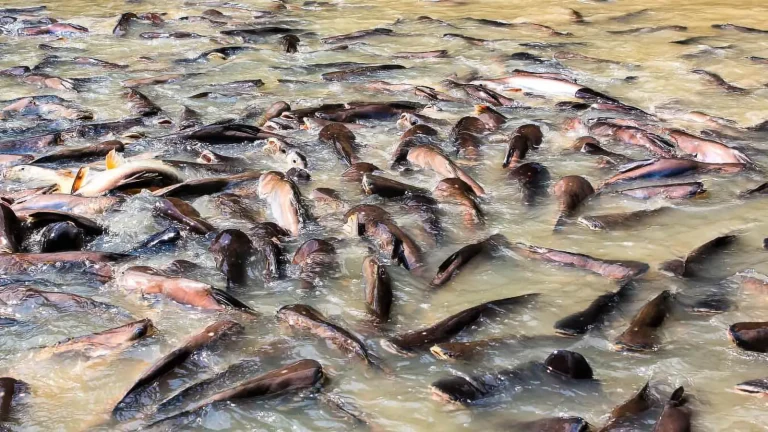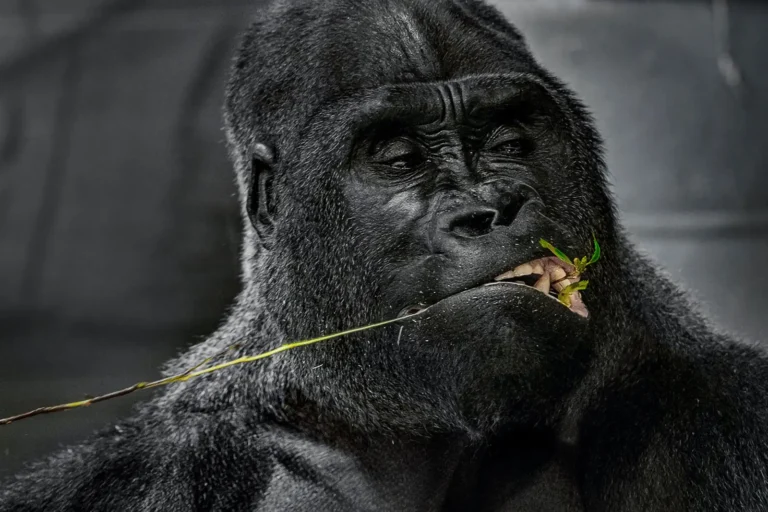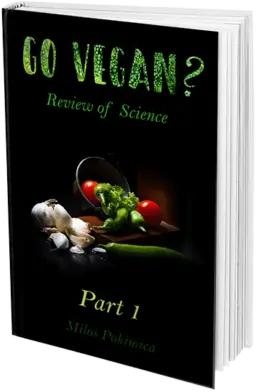Câncer, O que é Proibido Curas - ESSIAC
O Essiac é barato. O Essiac é atóxico. O Essiac é eficaz. O Essiac não pode ser patenteado.
Milos Pokimica
Escrito por: Milos Pokimica
Revisto Clinicamente Por: Dr. Xiùying Wáng, M.D.
Actualizado em 28 de Maio, 2023A verdade é falsa. Isto é Orwellian doublepeak. As ligações entre a indústria farmacêutica, os elitistas do cartel bancário que são proprietários dessa indústria, os estabelecimentos médicos, e os governos têm impulsionado a agenda não só para ganhar mais dinheiro mas para governar a condição humana como um todo. Hoje em dia, foi tão longe que é empurrado para debaixo do guarda-chuva da ONU.
Um dos aspectos mais "filosóficos" da agenda é a destruição sistemática da indústria de cuidados de saúde naturais, e o acesso natural a suplementos como um golpe final numa guerra contra as plantas que dura mais de 100 anos. E não são apenas as plantas que constituem um problema, porque não podem ser patenteadas. Não se trata de dinheiro. Trata-se de mais do que isso. Toda a verdadeira cura que destrói a doença nas suas raízes não é algo que a indústria queira, mesmo que possa ser patenteado. Não querem curas, apenas querem tratamentos que possam prolongar um pouco a vida. Vejamos exemplos da vida real.
Numa pequena cidade no norte de Ontário, em 1922, começaram a circular rumores sobre um chá que curava o cancro e que era originário das florestas de Ontário. A tribo canadiana Ojibwa usava originalmente uma mistura. Os índios chamavam essa mistura de “chá da vida”. Num dia fatídico em 1922, a enfermeira canadiana especializada em cancro, Rene Caisse, notou tecido cicatricial no peito de uma senhora inglesa idosa.
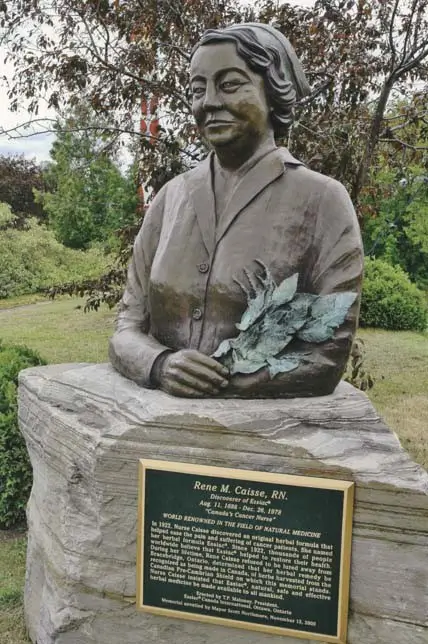
Ela foi diagnosticada com cancro da mama há 30 anos e curou-se naturalmente, sem cirurgia, o que não deveria ser possível, nem mesmo hoje em dia. A mulher simplesmente não tinha dinheiro para isso. Ela conheceu um curandeiro indígena que lhe disse que, na tradição da sua tribo, eles eram capazes de curar a doença com um chá.
Bem, a mulher não tinha nada a perder. Então, ela experimentou o chá, e funcionou para ela. Ela ainda estava viva 30 anos depois quando a enfermeira Caissie a examinou.
Ela também contou os ingredientes do remédio à base de ervas à enfermeira. Um ano depois, a enfermeira Caissie ainda não tinha feito nada em relação ao chá que ela lhe tinha falado, mas um médico local, durante um passeio, disse-lhe que, se o mundo usasse uma erva que tinham acabado de passar por ali, não haveria mais cancro da mama. Era uma das ervas do remédio à base de ervas do chá do curandeiro indígena.
A “erva daninha” era azedinha.
Em 1924, ela decidiu testar o chá na sua tia. A tia não tinha nada a perder, pois tinha cancro no estômago e a medicina convencional da época lhe dava cerca de seis meses de vida. Ela viveu mais 21 anos, sem cancro. Rene Caisse (pronuncia-se “Reen Case”) mais tarde deu o chá à sua mãe de 72 anos, que tinha sido diagnosticada com cancro inoperável no fígado, com apenas algumas semanas de vida. A sua própria mãe curou-se e viveu sem cancro por mais 18 anos. Após esses acontecimentos, a enfermeira Caisse decidiu deixar o hospital e começou a curar pessoas com uma mistura de ervas que ficaria conhecida como Essiac, que é o seu apelido escrito ao contrário.
Em breve a voz espalhou-se e o número de pacientes começou a crescer. Quando a Dra. Bestida de Bracebridge, Ontário enviou a Cassie o seu paciente Bert Rosin, ela curou-o, e a Dra. Bestida foi perante a câmara municipal e um presidente da câmara e persuadiu-os a dar o edifício à enfermeira Caisse como clínica. Assim, criaram a clínica porque Cassie fez uma grande descoberta e queriam que ela fosse apoiada pela sua própria cidade natal.
Ela tratou pacientes durante oito anos e meio, com pessoas a chegarem de todas as partes. Tratava cerca de seiscentos pacientes por semana, e a única forma de o fazer era gratuitamente e precisava de ter um diagnóstico médico para cada caso que tratava. Agora imagine se impuséssemos as mesmas regras à indústria do cancro dos dias de hoje.
No entanto, foi um tal Dr. Leonardo, de Buffalo, que reconheceu imediatamente o potencial dessa cura para o cancro e a alertou sobre o que iria acontecer. Ele era um cirurgião oncologista e perguntou se poderia ir à clínica examinar os pacientes para ver por si mesmo. Depois de ver por si mesmo, ele disse a Cassie que ela tinha a cura, mas que a classe médica nunca iria deixá-la fazer isso. Algum tempo depois da sua visita, um pequeno grupo de misteriosos “empresários” apareceu e ofereceu a Cassie uma pequena quantia de um milhão de dólares pela fórmula secreta. Naquela época, um milhão era uma grande quantia de dinheiro. O equivalente a 20 milhões hoje. Agora podemos pensar nisso como um suborno para mantê-la calada e levá-la para um lugar quente e agradável para se aposentar. O que essas pessoas não estavam dispostas a garantir era que a cura fosse disponibilizada gratuitamente ou mesmo disponibilizada para as pessoas que precisavam dela. Eles só queriam a fórmula e que ela fosse embora. A única razão pela qual sabemos disso hoje e você pode ler sobre isso é porque ela recusou. Ela era emotiva e não pragmática. Ela tratava as pessoas gratuitamente na clínica. Você teria recusado tal oferta? Quem em sã consciência recusaria? Quantas outras curas foram suprimidas por essa forma de suborno que não conhecemos e nunca conheceremos?
Em 1938, o seu caso foi levado à legislatura para determinar o estatuto legal do Essiac. Ela estava a tentar legalizar o seu tratamento. Os seus pacientes reuniram 55 000 assinaturas para uma petição. Um projeto de lei foi apresentado na legislatura de Ontário para (supostamente) “autorizar Rene Caisse a exercer medicina na província de Ontário no tratamento do cancro e condições relacionadas”. O projeto de lei não foi aprovado. A indignação pública forçou a criação de uma comissão de câncer para investigar os seus remédios, mas tudo foi rejeitado. Rene Caisse tratava os seus pacientes sob a supervisão de muitos médicos. Alguns desses médicos viram com os próprios olhos o que esse chá podia fazer, e oito deles assinaram uma petição ao Departamento de Saúde e Bem-Estar Nacional em Ottawa, pedindo que a enfermeira Caisse recebesse instalações para fazer pesquisas independentes sobre a sua descoberta. Inicialmente, Rene não estava familiarizada com o controlo que a indústria médica/farmacêutica tinha sobre os governos. Depois de a petição ter sido entregue, ela foi continuamente ameaçada de prisão até que finalmente se retirou da vida pública. Ela manteve a sua clínica enquanto pôde, até que impediram os médicos de fazerem o diagnóstico e ela foi forçada a parar. Os pacientes continuavam a procurá-la e, em alguns casos, imploravam-lhe que os tratasse, mas ela não podia fazê-lo sem um diagnóstico, pois seria presa por um longo período. Ela teve um colapso nervoso e fechou a clínica.
O Essiac era barato. O Essiac não é tóxico. O Essiac não pode ser patenteado.
Ela recusou o suborno.
No mundo normal, tal descoberta seria bem-vinda com as mãos abertas e a investigação seria feita extensivamente para ver qual é o caminho para a supressão do cancro. Neste mundo cheio de corrupção, coisas como esta são rotuladas como falsas e perigosas e, neste caso, os meios de comunicação social das empresas não poderiam demonizar a enfermeira Cassie porque ela não cobrou dinheiro pelo tratamento. Assim, eles simplesmente abateram silenciosamente a clínica e rotularam-na como uma cura falsa do cancro que as pessoas deveriam evitar sem qualquer investigação. Nessa altura, ela tinha um diagnóstico de médicos regulares. Tinha descobertas patológicas e pacientes vivos aos milhares que tiveram alta dos hospitais regulares e foram enviados para casa para morrer. Foram ter com ela nas últimas fases do cancro e viveram depois de a profissão médica os ter abandonado. No entanto, recusaram-se até a reconhecer quaisquer benefícios do chá Essiac sem sequer terem feito uma única investigação.
Até hoje, a Sociedade Americana contra o Cancro afirma que:
“As análises dos registos médicos de pessoas que foram tratadas com Essiac não corroboram as alegações de que este produto ajuda as pessoas com cancro a viver mais tempo ou que alivia os seus sintomas”, e a FDA descreveu o Essiac como uma “falsa cura para o cancro que os consumidores devem evitar‘.’
A Cancer Research UK também observa que:
”Não há evidências científicas de que o Essiac possa ajudar a tratar o cancro ou controlar os seus sintomas” e até alerta que: “O Essiac pode interagir com alguns tipos de tratamento contra o cancro, por isso é muito importante informar o seu médico se estiver a pensar tomar Essiac.”
Depois de recuperar-se do colapso, ela recomeçou do zero, preparando a mistura de ervas na sua própria cave e tratando um pequeno número de pacientes. Em pouco tempo, o governo começou a persegui-la novamente e mandou prendê-la mais de uma vez. Mas a história veio a público, e o médico pessoal de JFK, Dr. Charles Brusch, que também era seu amigo íntimo e que se tratou com Essiac quando lutou contra o cancro, enviou-lhe um convite para testar Essiac cientificamente. Caisse deu algumas amostras de Essiac ao Dr. Charles Brusch, que também era o fundador do Brusch Medical Center em Cambridge, Massachusetts, onde os testes foram realizados. Esses primeiros testes científicos mostraram que o Essiac não é tóxico e tem efeitos positivos na supressão do cancro. Naquela época, o Dr. Brusch recomendou que o Essiac fosse testado quanto à toxicidade para ser aprovado pela FDA como um possível tratamento contra o cancro.
Uma vez que o chá chegou ao processo do Sloan-Kettering Cancer Center, de alguma forma ficou encalhado. Um laboratório no Memorial Sloan-Kettering Cancer Center testou amostras da Essiac (fornecidas pela Caisse) em ratos durante a década de 1970. Este estudo nunca foi formalmente publicado. Há controvérsia em relação aos resultados. Houve atrasos inexplicáveis, e mais atrasos e processos nunca chegaram a qualquer conclusão. O Sloan-Kettering Cancer Center é supostamente um dos mais importantes centros de investigação do cancro nos EUA. Chester Stock, o co-director da Sloan-Kettering, quando entrevistado pela agência noticiosa, disse que os resultados que relatou mostraram que havia uma percentagem muito pequena no pequeno grupo de regressões, mas nunca tiveram a oportunidade de confirmar isto e de ver se conseguiam obter melhores resultados.
Assim, no final, a Essiac não foi aprovada pela FDA. A Caisse recusou ofertas dos investigadores do Memorial Sloan-Kettering e do Instituto Nacional do Cancro dos EUA para o acesso à receita. Foi tão longe que os próprios doentes começaram a organizar-se para processar o governo e a FDA em algumas ocasiões. Acreditavam que, ao abrigo da constituição, podiam colocar em si próprios qualquer substância que quisessem, desde que não fossem perigosos para os outros e que nenhuma FDA ou qualquer outra entidade lhes pudesse dizer o que podem ou não usar no seu próprio corpo, pelo que vários grupos de doentes se organizaram e processaram a FDA por lhes negar uma possível cura.
As audiências judiciais não levaram a lado nenhum, e sim os direitos constitucionais tinham sido-lhes negados.
O Dr. Frederick Banting, co-descobridor da insulina, interessou-se pelo Essiac e chegou a oferecer à enfermeira Caisse instalações de pesquisa para testá-lo mais a fundo, mas nessa altura Rene já tinha perdido a vontade de lutar. A única mulher em quem Rene Caisse confiava para ajudá-la a preparar o chá Essiac era a sua melhor amiga, Mary McPherson. Segundo o Dr. Gary Glum, Mary prometeu a Rene nunca partilhar a receita com ninguém. Foi o Dr. Glum que, em 1985, comprou a fórmula por $120.000 a um dos antigos pacientes de Rene. O Dr. Glum poderia ter mantido a fórmula em segredo e enriquecido vendendo frascos de Essiac. No entanto, ele generosamente divulgou a fórmula ao público em 1988. Inicialmente, ele ofereceu a fórmula em uma fita de vídeo que anunciou em seu livro, mas as autoridades federais apreenderam ilegalmente as fitas antes que ele pudesse vender muitas delas. O Dr. Glum distribuiu a fórmula e a receita do Essiac gratuitamente a qualquer pessoa que lhe enviasse um pedido pelo correio. Quando o Dr. Glum conheceu Mary McPherson em Bracebridge, Ontário, e lhe contou o que era a fórmula do Essiac, ela ficou mais do que um pouco surpreendida. De acordo com o Dr. Glum, Mary acabou por revelar a fórmula em 1994 porque já não era um segredo e ela queria acabar com a controvérsia sobre a fórmula do Essiac antes de morrer.
Portanto, em 23 de dezembro de 1994, a fórmula e receita do “Essiac” foram oficialmente registadas no domínio público com o depoimento de Mary McPherson.

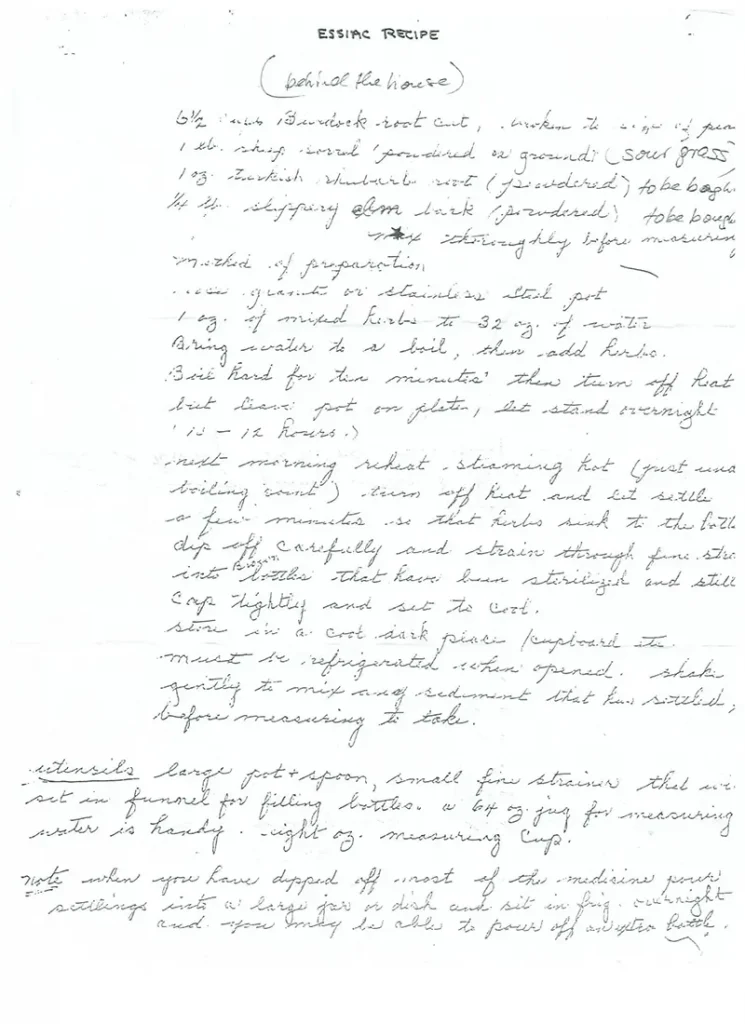
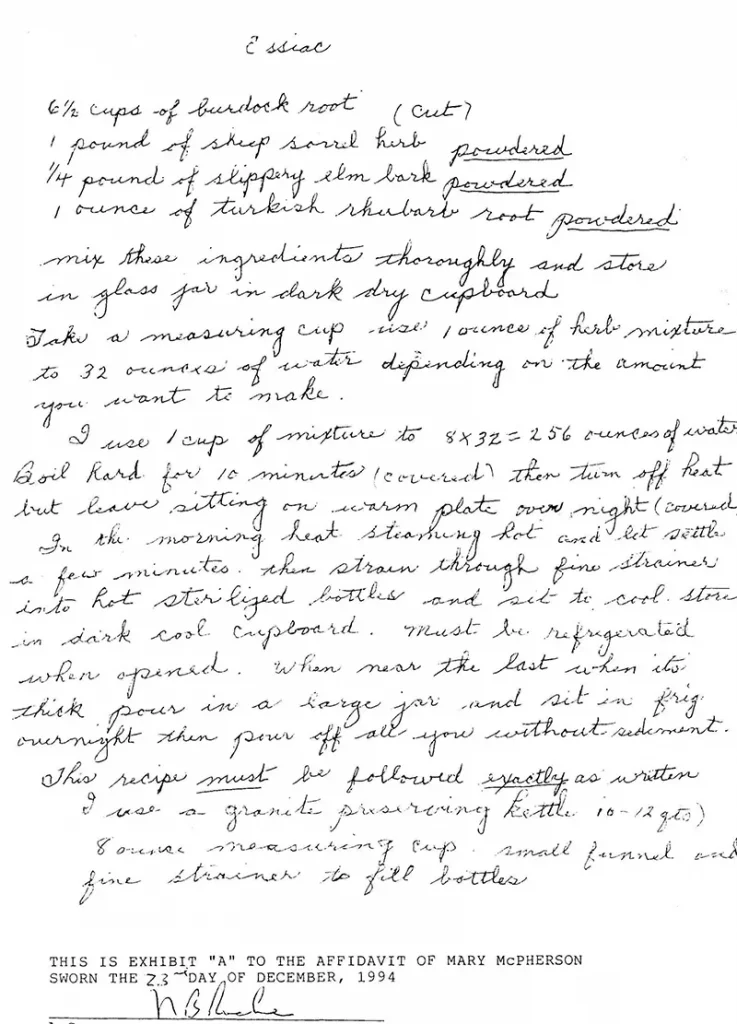
Essiac inclui uma mistura de diferentes ervas, incluindo a azevém (Rumex acetosella), mais tarde provada como sendo a mais potente. Depois também casca escorregadia de olmo (Ulmus fulva), raiz de bardana (Arctium lappa) e ruibarbo turco (Rheum palmatum).
O olmo-americano é a única erva Essiac nativa da América do Norte. O ruibarbo-turco (Rheum palmatum) é nativo da China e do Tibete, não do norte de Ontário, por isso parece improvável que fizesse parte da fórmula original do curandeiro com ervas indígenas no final do século XIX. Parece que tanto a bardana como a azedinha foram trazidas para este continente pela Europa pelos primeiros colonos, que depois transmitiram o seu conhecimento sobre estas duas ervas às tribos locais. A bardana e a azedinha acabaram por se espalhar por toda a América do Norte, onde havia água suficiente. Rene Caisse indicou que a azedinha era uma das ervas originais, pelo que parece que a azedinha tinha migrado para “as florestas do norte de Ontário” antes da década de 1890. A bardana também pode ter-se estabelecido no norte de Ontário nessa altura. René Caisse considerava que a azedinha era a erva mais eficaz no combate ao cancro entre todas as ervas presentes na sua fórmula. O Dr. Chester Stock partilhava essa opinião no Sloan-Kettering. O Dr. Stock realizou alguns estudos sobre os benefícios da azedinha durante mais de três anos, em meados da década de 70.
Volume da erva Forma Peso da receita % Receita
Corte de ervilha de raiz de bardana 53%.
Sorrel de ovelha em pó a 36%.
Casca de Olmo Escorregadio em pó 9%.
Turquia Rhubarb Root Powdered 2%.
Em 2012, foi realizado um estudo na Hungria. Os resultados de um estudo realizado na Hungria foram publicados e mostraram que a erva Sheep Sorrel, e alguns dos seus parentes Sorrel, demonstraram uma actividade inibitória substancial do crescimento celular (pelo menos 50% de inibição da proliferação celular) contra uma ou mais linhas celulares cancerosas.
Um ponto para os ervanários.
Uma pesquisa realizada no ano 2000 descobriu que aproximadamente 15% de mulheres canadianas com cancro da mama estavam a usar Essiac. Também se tornou popular entre pessoas com doenças imunológicas, como HIV e diabetes, e como um chá de ervas regular. Algumas medidas preventivas em indivíduos orientados para a saúde. Pesquisas realizadas desde a morte de Caisse forneceram algumas informações.
Ervas utilizadas na produção de Essiac antioxidante e propriedades anti-cancerígenas, de acordo com a investigação realizada no Instituto Europeu de Oncologia. Os resultados foram relatados no número de Março de 2006 do Journal of Ethnopharmacology. Os investigadores descobriram que quatro das ervas da Essiac demonstraram poderes naturais de protecção contra o cancro.
Finalmente, uma pesquisa rápida no arquivo PubMed pode dar-nos alguns estudos como (Ottenweller et al., 2004). Examinaram a linha de células cancerosas e as células do baço in vitro que tinham sido isoladas de ratos para examinar as respostas de proliferação mediadas pela adição de um Essiac. Verificaram uma diminuição da proliferação da linha de células da próstata transformadas e cancerosas quando o Essiac estava presente nos meios de cultura, o que significa que o chá impediu todas as células de se dividirem, mas a percentagem de inibição das células cancerosas foi superior à percentagem de inibição das células normais, o que implica que o Essiac pode ter um efeito selectivo adicional nas células cancerosas. Além disso, os efeitos do Essiac foram medidos num ensaio de proliferação de linfócitos T imunes. Com doses baixas de Essiac, foi demonstrado um aumento da proliferação destas células T, mas com doses mais elevadas, o Essiac foi inibidor da proliferação das células T. Isto significa que o Essiac pode ter um efeito selectivo adicional nas células cancerígenas. Isto significa que o Essiac s pode ser capaz de inibir o crescimento das células tumorais ao mesmo tempo que aumenta a resposta imunitária. Isto pode ser particularmente importante em indivíduos imunodeprimidos. Como no HIV.
No presente estudo(Seely et al., 2007). O Essiac apresentou antioxidante demonstraram efeitos imunomoduladores significativos, especificamente através da estimulação da fagocitose de granulócitos e da inibição moderada das vias inflamatórias. A Essiac exibiu uma significativa citotoxicidade específica das células para as células do carcinoma epitelial ovariano (o que significa que mata o cancro). Concluíram que este estudo foi a primeira investigação abrangente dos efeitos in vitro do Essiac e que a análise in vitro do Essiac indica propriedades antioxidantes e imunomoduladoras significativasbem como citotoxicidade específica para células neoplásicas (uma célula que faz parte do tumor) (específica para matar apenas células cancerígenas), o que é consistente com as propriedades históricas atribuídas a este composto. Há também outros estudos que não encontraram nada e até um estudo que encontrou um risco aumentado de cancro da mama (Kulp et al., 2006).
Por isso, mais uma vez, temos ciência em conflito. Cem anos desde o aparecimento dos Essiac, ainda não temos uma imagem clara. Num mundo onde supostamente há centenas de milhões de dólares gastos anualmente em investigação sobre o cancro (a razão pela qual todos estes medicamentos contra o cancro supostamente custam tanto), de alguma forma é difícil fazer um simples exame de chá e investigação. Ou qualquer outro exame para curas "alternativas" para esse fim.
A resposta da FDA é que a razão pela qual eles não testam esses produtos é que não querem dar credibilidade aos charlatões. E eles estão a mentir. Eles não querem dar às “alternativas” qualquer chance de provar a sua eficácia porque não estão lá para proteger ou curar as pessoas.
Eles estão lá para proteger o grande negócio farmacêutico de Rockefeller. Há muitos casos a serem citados sobre investigações do Congresso. Acabei de usar o Essiac como um exemplo. Se quiser, pode ler as audiências de 1963 do senador Paul Douglas, de Illinois, sobre o Krebiozen.
Referências:
- Ottenweller, J., Putt, K., Blumenthal, E. J., Dhawale, S., & Dhawale, S. W. (2004). Inibição da proliferação de células de cancro da próstata por Essiac. Jornal de medicina alternativa e complementar (Nova Iorque, N.Y.), 10(4), 687-691. https://doi.org/10.1089/acm.2004.10.687
- Seely, D., Kennedy, D. A., Myers, S. P., Cheras, P. A., Lin, D., Li, R., Cattley, T., Brent, P. A., Mills, E., & Leonard, B. J. (2007). Análise in vitro do composto herbal Essiac. Investigação anticancerígena, 27(6B), 3875-3882. [PubMed]
- Kulp, K. S., Montgomery, J. L., Nelson, D. O., Cutter, B., Latham, E. R., Shattuck, D. L., Klotz, D. M., & Bennett, L. M. (2006). Os tónicos à base de plantas Essiac e Flor-Essence estimulam o crescimento in vitro de células humanas de cancro da mama. Investigação e tratamento do cancro da mama, 98(3), 249-259. https://doi.org/10.1007/s10549-005-9156-x
Publicações Relacionadas
Você tem alguma dúvida sobre saúde e nutrição?
Eu adoraria ouvir de você e respondê-las em meu próximo post. Agradeço sua contribuição e opinião e espero ouvir de você em breve. Eu também convido você a siga-nos no Facebook, Instagram e Pinterest para mais conteúdos sobre dieta, nutrição e saúde. Pode deixar um comentário e ligar-se a outros entusiastas da saúde, partilhar as suas dicas e experiências e obter apoio e encorajamento da nossa equipa e comunidade.
Espero que este post tenha sido informativo e agradável para si e que esteja preparado para aplicar os conhecimentos que aprendeu. Se achou este post útil, por favor partilhá-lo com os seus amigos e familiares que também possam beneficiar com isso. Nunca se sabe quem poderá precisar de alguma orientação e apoio no seu percurso de saúde.
– Você Também Pode Gostar –

Aprender Sobre Nutrição
Milos Pokimica é médico de medicina natural, nutricionista clínico, escritor de saúde e nutrição médica, e conselheiro em ciências nutricionais. Autor da série de livros Go Vegan? Revisão de Ciênciaopera também o website de saúde natural GoVeganWay.com
Medical Disclaimer
GoVeganWay.com traz análises das pesquisas mais recentes sobre nutrição e saúde. As informações fornecidas representam a opinião pessoal do autor e não pretendem nem implicam substituir aconselhamento, diagnóstico ou tratamento médico profissional. As informações fornecidas são apenas para fins informativos e não se destinam a servir como substituto para consulta, diagnóstico e/ou tratamento médico de um médico ou profissional de saúde qualificado.NUNCA DESCONSIDERE o CONSELHO MÉDICO PROFISSIONAL OU adiar a BUSCA de TRATAMENTO MÉDICO por causa DE ALGO QUE TENHA LIDO OU ACESSADO por MEIO de GoVeganWay.com
NUNCA APLIQUE QUAISQUER MUDANÇAS de estilo de VIDA OU QUALQUER MUDANÇA COMO UMA CONSEQUÊNCIA DE ALGO QUE TENHA LIDO NO GoVeganWay.com ANTES de CONSULTORIA de LICENÇA MÉDICA.
No caso de uma emergência médica, ligue para o médico ou para o 911 imediatamente. GoVeganWay.com não recomenda ou endossa qualquer específicos, grupos, organizações, exames, médicos, produtos, procedimentos, opiniões ou outras informações que podem ser mencionadas dentro.
Sugestões do Editor –
Milos Pokimica é escritor especializado em saúde e nutrição e consultor em ciências nutricionais. Autor da série de livros Go Vegan? Revisão de Ciênciaopera também o website de saúde natural GoVeganWay.com
Artigos Mais Recentes -
Superior De Saúde De Notícias — ScienceDaily
- This weight loss option beats Ozempic by 5 timeson Janeiro 7, 2026
Bariatric surgery far outperformed GLP-1 weight loss drugs in a new real-world comparison of more than 50,000 patients. Two years after treatment, surgery patients lost about 58 pounds on average, while those using semaglutide or tirzepatide lost roughly 12 pounds. Even patients who stayed on GLP-1 drugs for a full year saw much smaller results than surgical patients. High dropout rates and real-world challenges appear to blunt the drugs’ effectiveness.
- Japanese scientists just built human brain circuits in the labon Janeiro 7, 2026
Researchers in Japan built a miniature human brain circuit using fused stem-cell–derived organoids, allowing them to watch the thalamus and cortex interact in real time. They found that the thalamus plays a decisive role in maturing the cortex and organizing its neural networks. Signals from the thalamus triggered synchronized activity in specific neuron types, while others remained unaffected. The system closely mimics human brain development and could transform how scientists study […]
- Ancient skeletons reveal viruses embedded in human DNAon Janeiro 7, 2026
Researchers have reconstructed ancient herpesvirus genomes from Iron Age and medieval Europeans, revealing that HHV-6 has been infecting humans for at least 2,500 years. Some people inherited the virus directly in their DNA, passing it down across generations. The study shows that these viruses evolved alongside humans—and that one strain eventually lost its ability to integrate into our chromosomes. It’s the first time this long, intimate relationship has been proven with ancient genetic […]
- Magnetic nanoparticles fight bone cancer and help healingon Janeiro 7, 2026
Researchers have developed a magnetic nanomaterial that can kill bone cancer cells and support bone regeneration at the same time. The material heats up under a magnetic field to destroy tumors, while its bioactive coating helps it bond to bone and stimulate healing. Tests showed rapid formation of bone-like minerals, a key sign of successful integration. The breakthrough could lead to smarter, less invasive treatments for bone tumors.
- A global cancer surge is underway and the world is not readyon Janeiro 7, 2026
Global cancer cases have surged dramatically, doubling since 1990 and reaching 18.5 million new diagnoses in 2023. Deaths have also climbed to over 10 million a year, with the steepest increases hitting low- and middle-income countries. Without urgent action, researchers project more than 30 million new cases annually by 2050. Alarmingly, around four in ten cancer deaths are tied to preventable risks such as smoking, poor diet, and high blood sugar.
- Wildfires are polluting the air far more than thoughton Janeiro 7, 2026
Scientists have discovered that wildfires release far more air-polluting gases than previously estimated. Many of these hidden emissions can transform into fine particles that are dangerous to breathe. The study shows wildfire pollution rivals human-made emissions in some parts of the world. This helps explain why wildfire smoke can linger and worsen air quality long after the flames are gone.
- The simplest way teens can protect their mental healthon Janeiro 7, 2026
Teens who sleep in on weekends may be giving their mental health a boost. A new study found that young people who made up for lost weekday sleep had a significantly lower risk of depression. While consistent sleep is still best, weekend catch-up sleep appears to offer meaningful protection. The findings highlight how powerful sleep can be for adolescent well-being.
PubMed, #vegan-dieta –
- Exploring Experiences and Practices of Contemporary Vegans in Australia: A Qualitative Studyon Janeiro 7, 2026
CONCLUSIONS: Nutrition interventions supporting individuals to adopt plant-based dietary patterns are more likely to be successful if compelling benefits are articulated and reinforced. Quality information about overcoming practical challenges is required. However, long-term adherence is more likely if psychosocial resilience is supported.
- Response to Letter to the Editor: Iron, zinc, and iodine in vegan youthon Janeiro 4, 2026
No abstract
- Impact of alpha-linolenic acid supplementation on long-chain n-3 fatty acid profiles in Western, flexitarian, vegetarian, and vegan dietson Dezembro 31, 2025
CONCLUSION: In conclusion, flaxseed oil supplementation combined with a controlled diet effectively improves n-3 LCPUFA status irrespective of habitual diet. The extent of relative improvement was primarily determined by baseline EPA concentrations.
- Vegetarian Dietary Patterns for Adults: A Position Paper of the Academy of Nutrition and Dieteticson Dezembro 31, 2025
It is the position of the Academy of Nutrition and Dietetics that, in adults, appropriately planned vegetarian and vegan dietary patterns can be nutritionally adequate and can offer long-term health benefits such as improving several health outcomes associated with cardiometabolic diseases. Vegetarian dietary patterns exclude meat, poultry, and seafood, and vegan dietary patterns exclude all foods of animal origin. Registered dietitian nutritionists (RDNs) and nutrition and dietetics…
- Academy of Nutrition and Dietetics’ Vegetarian Position Paper Mistakenly Links Vegetarian and Vegan Diets with Vitamin D Deficiencyon Dezembro 31, 2025
No abstract
Postagens aleatórias –
Postagens em destaque –
Últimas do PubMed, #dieta baseada em vegetais –
- Exploring Experiences and Practices of Contemporary Vegans in Australia: A Qualitative Studypor Linda Smillie on Janeiro 7, 2026
CONCLUSIONS: Nutrition interventions supporting individuals to adopt plant-based dietary patterns are more likely to be successful if compelling benefits are articulated and reinforced. Quality information about overcoming practical challenges is required. However, long-term adherence is more likely if psychosocial resilience is supported.
- Ancient biomolecules suggest a learned foraging strategy in extinct cave bearspor Ioana N Meleg on Janeiro 7, 2026
Studying the behavioral ecology of long-extinct species is challenging due to the difficulty in measuring the behavioral phenotype and correlating this with genetic and environmental factors. However, a multidisciplinary approach integrating isotope analysis of diet and ancient DNA analysis of genetic relationships offers a potential framework to test the proximate causes of dietary preferences. Our study focuses on Late Pleistocene cave bears from the Romanian Carpathians. Stable isotope…
- Indigenous Comprehension of Fodder Trees and Shrubs in Semiarid Areas of Metema District, Northwestern Ethiopiapor Yirgalem Melkamu on Janeiro 7, 2026
CONCLUSIONS: This study revealed that the indigenous communities of Metema District possess high knowledge of tree and shrub fodder plants. The plants are vital components of their livestock feeding systems to improve their livelihoods.
- Parent Perspectives on the Interactive Role of Charitable and Federal Nutrition Assistancepor Cristina M Gago on Janeiro 6, 2026
CONCLUSIONS: The experiences of pantry users with children underscore the need to reinvest in charitable and federal nutrition assistance programs, broaden the eligibility criteria, and alleviate the administrative burden associated with federal nutrition program access.
- Enhancing Gluten-Free Cake Quality With Germinated and Ungerminated Mung Bean Flours: A Comparative Analysispor Sultan Acun on Janeiro 6, 2026
Gluten-free (GF) baked products are often constrained by limited nutritional quality and a lack of bioactive compounds. This study investigates the incorporation of germinated mung bean flours (GMBF) and ungerminated mung bean flours (UMBF) into GF cake formulations as partial (50%) or complete (100%) substitutes for rice flour. Comprehensive analyses were conducted on both cakes and raw flours, including proximate composition, total phenolic content (TPC), antioxidant activity…
- Quality-oriented diet therapy for chronic kidney diseasepor Juan J Carrero on Janeiro 6, 2026
Traditional dietary advice for people living with chronic kidney disease (CKD) focused predominantly on the quantity of energy and protein provided by the diet as well as restricting the consumption of single micronutrients. However, flaws in the assumptions that underlie this quantity-based approach have led to re-examination of medical nutrition therapy for kidney-related conditions, with a shift towards recommending more varied and liberalized plant-rich diets with a focus on dietary […]
